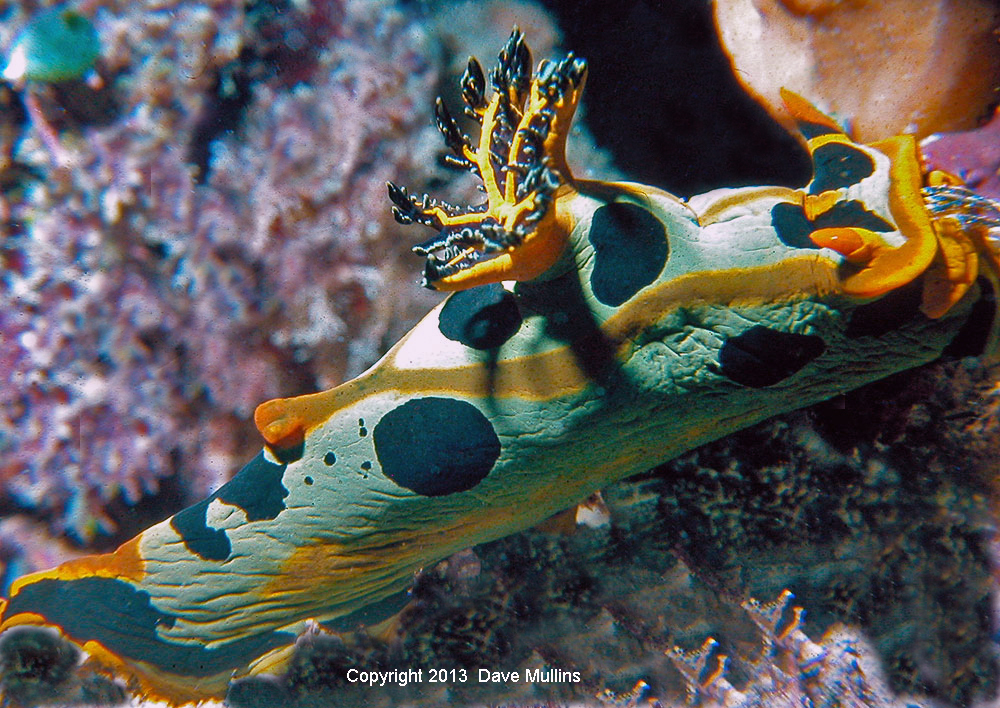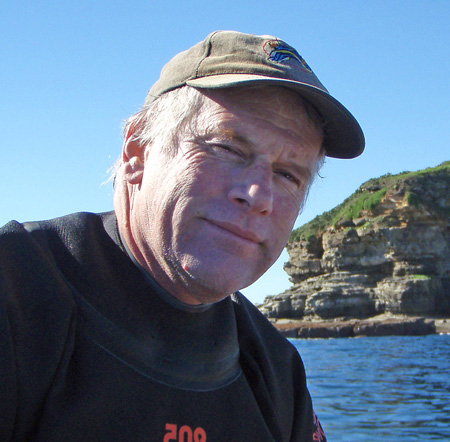 |
Tambja blacki
Image courtesy of David MullinsHeron Island, Great Barrier Reef, Australia
Photo taken in 1978
Tambja blacki Pola, Cervera, & Gosliner, 2006
In this post we revisit Tambja blacki one of those incredibly patterned polycerids. The Webmaster inquired, just as an afterthought in an email to me, if I might have any photos of this species. I recognized it immediately but realized that it would not be found in any of my digital files. I knew that I would have to go back to the "good old days" of film when I was doing a lot of diving on the southern end of the Great Barrier Reef. Just how far back would I have to go?...way back, 35 years to my slide film collection of 1978 in fact.
Tambja blacki is a distinctive polycerid due to its large size, patterning and colouration. It is also known to swim. "This undescribed species [at the time] of Tambja swims readily by strong side-to-side flexions when it is irritated. This process involves the whole body which becomes greatly laterally compressed. Even the rhinophores fold posteriorly on top of the body and the gills become contracted for greater streamlining. The ability to swim is unique in the Polyceridae." (Marshall & Willan, 1999)
It is believed to feed upon the aborescent bryozoan Amastigia rudis and it may actually be this bryozoan that is visible to the extreme right in the above photo. The nudibranch appears to be feeding upon it. Distribution has been generally recorded as the Great Barrier Reef, Australia and Papua New Guinea, however there are recent findings in Indonesia which would not be unexpected. This colour form and the colour of the specimen in the first post (#506) serve to prove the range of colour related in the original description.
Looking through my old slide collections brought back many memories of diving and taking underwater photos in those early days. Whilst the early '70's could not be considered pioneer diving it was certainly a primitive exercise then compared to today. What I didn't have included: dive watch, depth gauge, contents gauge, BCD, second demand valve (occy). What I did have included a non-balanced reg and a J valve tank that wouldn't deliver air once the tank pressure got to below 500psi (35Bar) and that constituted a reserve that could be accessed by pulling a lever attached to the valve. Depth was read from the boat sounder and length of dive calculated from entry and exit times. The size of the standard tank (72 cu ft.) usually meant you stayed out of deco.
I've never dived without a camera and even took it on my certification dives. Underwater photography was in its infancy and very few divers were interested in this expensive extension to the sport. I couldn't afford one of the big SLRs and the housings that were starting to be made but I thought I was in heaven when I sold off my Nemrod Siluro and bought a Nikonos II. At first I had a flash bulb gun for lighting but the bulbs would only work 75% of the time. Two socks were tucked into my weight belt, the left for new bulbs, the right for used. Or was it the other way around? Perhaps this is why they didn't always fire. I moved on to an electronic flash gun in a PVC housing, the only control being an on/off switch. Oh, the wonderful reliability. Exposure was calculated by multiplying an F-number, supplied by the manufacturer, by the distance from the subject in feet. Focus distance was also estimated and dialed into the lens. Composition was through a plastic framer using the parallax method or a wire pointer for macro work. I would take 36 exposures and on Monday drive over to the commercial photo lab (much quicker than waiting a week or more for Kodak) and then pick them up the next day as strips. I would cut them up and mount into slide frames myself the few that were any good. Until this point there was no way of knowing how many, if any, of the shots were successful. Quality depended upon getting three things right - FEC. Focus - Exposure - Composition and through trial and error over time eventually some good images were obtained. Exposure bracketing was a necessity as Photoshop wasn't even a dream then. So from 36 exposures I would be a very happy diver to have 5 or 6 keepers.
Were they really the "good old days"?
References:
Willan & Coleman 1984. Nudibranchs of Australia, Neville Coleman, AMPI, Sydney.
Marshall & Willan 1999. Nudibranchs of Heron Island, Great Barrier Reef, Backhuys Publishers.
Coleman N. 2008. Nudibranchs - Encyclopedia - Catalogue of Asia/Indo-Pacific Sea Slugs, Neville Coleman's Underwater Geographic Pty Ltd.
Gosliner, T.M., Behrens, D.W. & Valdes, A. 2008. Indo-Pacific Nudibranchs and Sea Slugs. Sea Challengers Natural History Books & California Academy of Sciences.
Queensland, Australia
Send Dave email at marineimages@hotmail.com
May 2013
WEBMASTER'S NOTES: Although somewhat behind Dave in the time curve having certified in 1977 and taking pictures in 1979, I can relate to the "good old days" but whether it was good day or otherwise really depended on whether we could keep our camera equipment going at that time. Most of our topside time was spent on camera maintenance, e.g. EO connections that wouldn't work, strobes that wouldn't fire, etc.! Discussions of marine biology took second fiddle to technical give and take regarding our camera equipment. With only 36 frames to work with per dive, we really had to concentrate on composition, lightning, most of which can be dealt with post production nowdays with the advent of home computers and Photoshop! Good old days? For me, I think so, in spite of all the gyrations we went through maintaining our cameras and dive gear!
David Mullins
 |
Dave Mullins has been taking underwater photos since 1970 and seen and embraced a host of changes and developments in diving and underwater photographic equipment and practices since then. He dived the Great Barrier Reef, Australia for many many years however for the past ten years he has focused his efforts almost entirely upon the Sunshine Coast, Queensland, Australia documenting the sea slugs of the region. To adequately survey the area he operates both a 5 metre RIB on the Sunshine Coast and a 10 metre powercat out of Scarborough on Moreton Bay. Together with Gary Cobb he has found 543 species of sea slug in this area alone that have been recorded and posted on their website:
nudibranch.com.au He has retired from his engineering business and recently taken on the CRITTER ID column in SportDiving Magazine (formerly by the late & great Neville Coleman) with the assistance of several world-renowned experts. Visit his website: www.marineimages.info and use the CRITTER ID Portal there to have your critters identified or confirmed and published in the magazine. |
